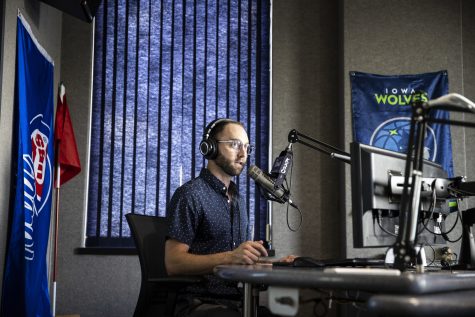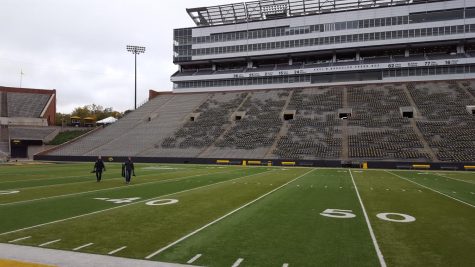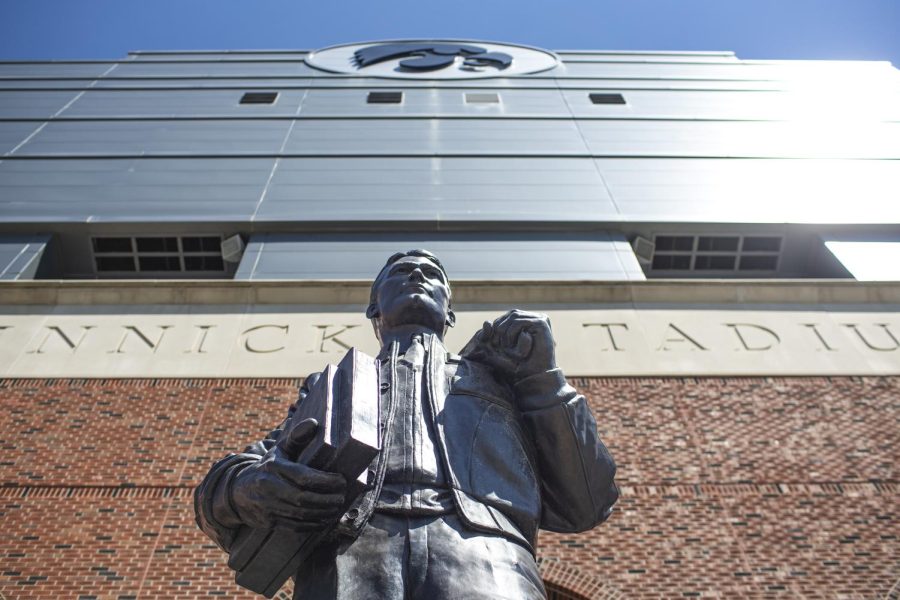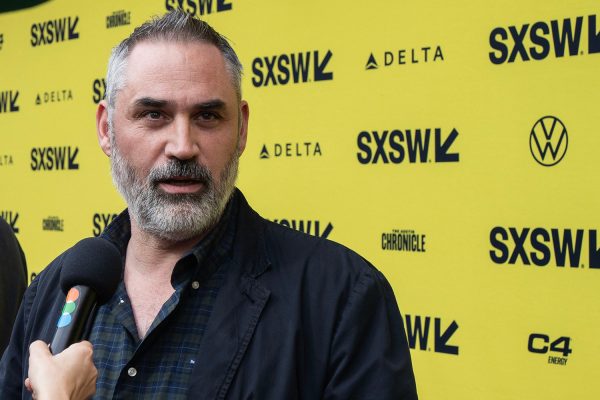Nile Kinnick’s legacy explored in new documentary
“Kinnick: The Documentary,” produced by Scott Siepker, provides new insight on the life of Iowa’s only Heisman Trophy winner.
The Nile Kinnick statue is seen outside of Kinnick Stadium in Iowa City on Monday, Aug. 1, 2022.
August 2, 2022
An Iowa State alumnus and his team are breathing life back into Iowa Hawkeye great Nile Kinnick through a 90-minute film, “Kinnick: The Documentary,” which will be released on Vimeo Aug. 24.
Producer Scott Siepker, also known as the Iowa Nice Guy, and his Des Moines-based filmmaking team, Goldfinch Films, had an idea 10 years ago to profile Kinnick, along with Iowa State football great Jack Trice, to explore why the two universities named football stadiums after the collegiate football standouts.

Siepker said it was clear with that idea there was too much material to fit into a consumable documentary and the film shifted toward Kinnick alone.
The decision was based on how much content had already been collected on Kinnick by Siepker and his team.
Kinnick, Iowa’s sole winner of college football’s Heisman Trophy and whose famous 1939 Heisman acceptance speech still echoes through Kinnick Stadium in Iowa City before games, died June 2, 1943, off the coast of Venezuela in a Naval training flight.
Kinnick’s famous speech prompted Boston Post writer Bill Cunningham to write “This country’s O.K. as long as it produces Nile Kinnicks,” which Siepker said is a quote explored in the film.
“Kinnick really is a guy worth honoring and worth kind of holding up as someone to remember,” co-director Cristopher Cook said.
Siepker said he was able to raise $20,000 from three individual donors and an additional $20,000 came from the Iowa Department of Cultural Affairs Greenlight Grant in 2020, which is funded by the Iowa Legislature and provides money for Iowa-based films.
The Greenlight Grant gave $140,000 the year Siepker applied. “Kinnick: The Documentary” and their $20,000 represented about 14 percent of that funding.

Siepker said much of the work he does is for other companies, but when the COVID-19 pandemic struck in 2020, opportunities to make videos for other companies dried up and gave the team time to sit down and finish the project.
While focusing on the film, the team fell in love with Kinnick’s first cousin Don Bice’s perspective.
“He’s really the only one left who had extensive time with Nile and Don’s now in his mid-90s,” Siepker said.
Keith Murphy, a sports anchor for Channel 13 in Des Moines and an early watcher of the film, added to how important Bice’s presence on camera was to the documentary while speaking on a radio show called “Murph and Andy” for 106.3 KXNO.
“[Bice] was so charismatic and such a good storyteller,” Murphy said.

As more time passes since Kinnick’s death, many questions about an Iowa legend remain unanswered, Siepker said. In order to get new content and learn more about Kinnick, Siepker and his crew culled through several different archives both locally and nationally.
“There’s this one wonderful night where I’m at my desk by myself. All the lights are off and I’m going through the National Archive photos. I’m just going through aircraft carrier photos from the time Nile was alive and all of a sudden I come across this photo … and I’m like, well that looks like Nile,” Siepker said.
Cautiously, Siepker scanned the surroundings of the photo and the background and asked himself a question.
“Is it late, or am I looking at a photo no one has ever seen of Nile Kinnick,” Siepker asked himself after discovering a photo of Kinnick sporting a huge grin.
While up late and with no one to celebrate the find, Siepker said he began jumping up and down.
“I hope that maybe there’s some people out there who get so motivated by [the film] and they start digging in and the more hands we get to dig through research, the more likely we are to get more and more answers,” Siepker said.

Both Siepker and Cook said viewers don’t need to be Hawkeye fans to be impacted by the film.
“It’s not so much a University of Iowa story and talking about how great the University of Iowa is, it really is talking about this son of Iowa,” Cook said. “Nile, he’s the grandson of [George W. Clarke] a former Iowa governor. He’s an Iowan through and through.”
While promoting the film on a late-July edition of Murphy’s radio show, Murphy complimented Siepker and his team’s ability to breathe life back into Kinnick.
“What I loved about it is, Nile Kinnick to me is a stadium, he’s a statue, he’s a speech,” Murphy said. “You turn him back into a man.”













